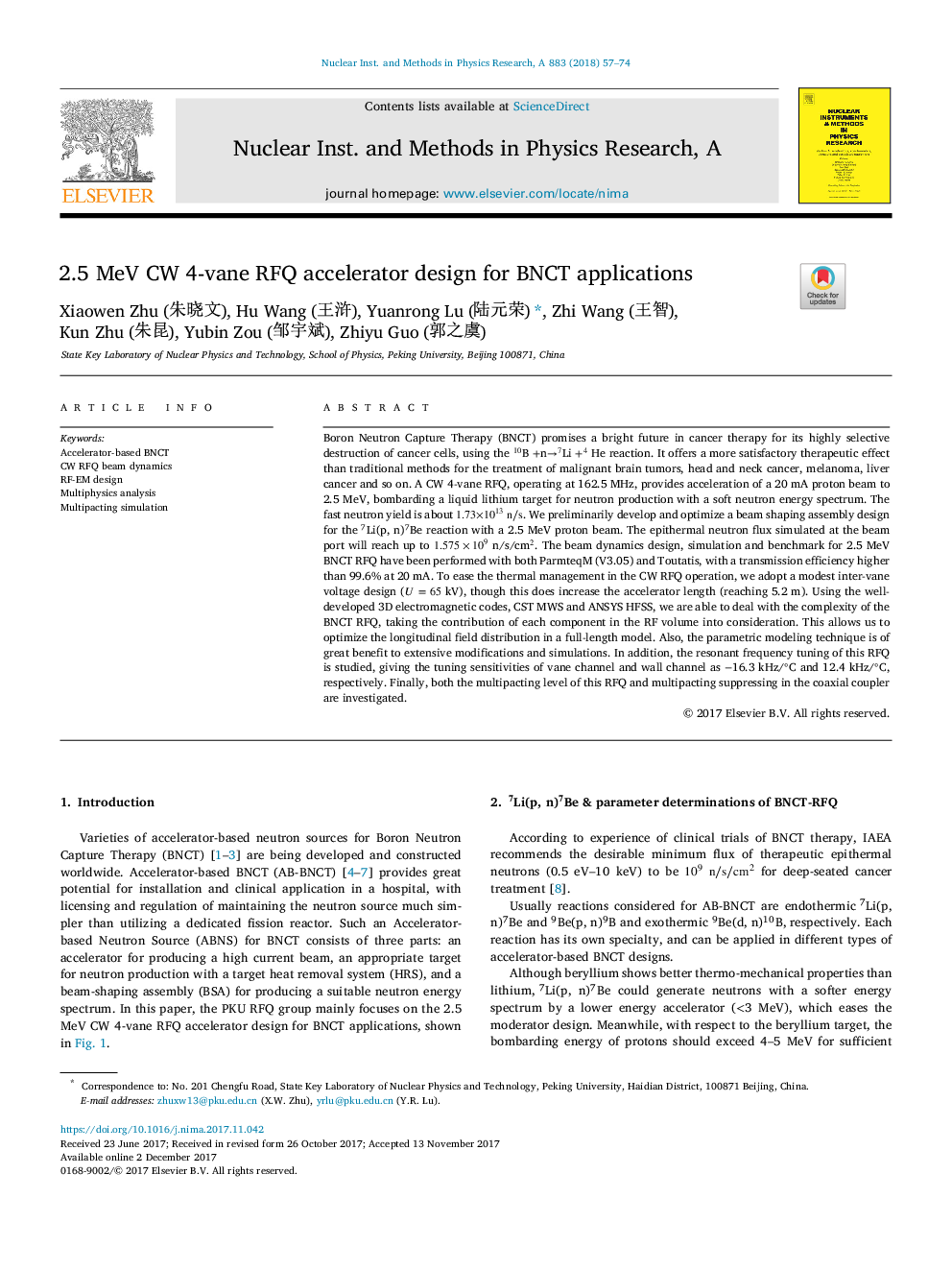| کد مقاله | کد نشریه | سال انتشار | مقاله انگلیسی | نسخه تمام متن |
|---|---|---|---|---|
| 8166967 | 1526243 | 2018 | 18 صفحه PDF | دانلود رایگان |
عنوان انگلیسی مقاله ISI
2.5 MeV CW 4-vane RFQ accelerator design for BNCT applications
دانلود مقاله + سفارش ترجمه
دانلود مقاله ISI انگلیسی
رایگان برای ایرانیان
کلمات کلیدی
موضوعات مرتبط
مهندسی و علوم پایه
فیزیک و نجوم
ابزار دقیق
پیش نمایش صفحه اول مقاله

چکیده انگلیسی
Boron Neutron Capture Therapy (BNCT) promises a bright future in cancer therapy for its highly selective destruction of cancer cells, using the 10B +nâ7Li +4 He reaction. It offers a more satisfactory therapeutic effect than traditional methods for the treatment of malignant brain tumors, head and neck cancer, melanoma, liver cancer and so on. A CW 4-vane RFQ, operating at 162.5 MHz, provides acceleration of a 20 mA proton beam to 2.5 MeV, bombarding a liquid lithium target for neutron production with a soft neutron energy spectrum. The fast neutron yield is about 1.73Ã1013nâs. We preliminarily develop and optimize a beam shaping assembly design for the  7Li(p, n)7Be reaction with a 2.5 MeV proton beam. The epithermal neutron flux simulated at the beam port will reach up to 1.575Ã109 n/s/cm2. The beam dynamics design, simulation and benchmark for 2.5 MeV BNCT RFQ have been performed with both ParmteqM (V3.05) and Toutatis, with a transmission efficiency higher than 99.6% at 20 mA. To ease the thermal management in the CW RFQ operation, we adopt a modest inter-vane voltage design (U=65 kV), though this does increase the accelerator length (reaching 5.2 m). Using the well-developed 3D electromagnetic codes, CST MWS and ANSYS HFSS, we are able to deal with the complexity of the BNCT RFQ, taking the contribution of each component in the RF volume into consideration. This allows us to optimize the longitudinal field distribution in a full-length model. Also, the parametric modeling technique is of great benefit to extensive modifications and simulations. In addition, the resonant frequency tuning of this RFQ is studied, giving the tuning sensitivities of vane channel and wall channel as â16.3 kHz/°C and 12.4 kHz/°C, respectively. Finally, both the multipacting level of this RFQ and multipacting suppressing in the coaxial coupler are investigated.
ناشر
Database: Elsevier - ScienceDirect (ساینس دایرکت)
Journal: Nuclear Instruments and Methods in Physics Research Section A: Accelerators, Spectrometers, Detectors and Associated Equipment - Volume 883, 1 March 2018, Pages 57-74
Journal: Nuclear Instruments and Methods in Physics Research Section A: Accelerators, Spectrometers, Detectors and Associated Equipment - Volume 883, 1 March 2018, Pages 57-74
نویسندگان
Xiaowen (æ±ææ), Hu (çæµ), Yuanrong (éå
è£), Zhi (çæº), Kun (æ±æ), Yubin (é¹å®æ), Zhiyu (éä¹è),